
Sir William Hamo Thornycroft was an English sculptor, responsible for some of London's best-known statues, including the statue of Oliver Cromwell outside the Palace of Westminster. He was a keen student of classical sculpture and was one of the youngest artists to be elected to the Royal Academy, in 1882, the same year the bronze cast of Teucer was purchased for the British nation under the auspices of the Chantrey Bequest.

Frederic Leighton, 1st Baron Leighton,, known as Sir Frederic Leighton between 1878 and 1896, was a British Victorian painter, draughtsman, and sculptor. His works depicted historical, biblical, and classical subject matter in an academic style. His paintings were enormously popular, and expensive, during his lifetime, but fell out of critical favour for many decades in the early 20th century.

Holland Park is an area of Kensington, on the western edge of Central London, that contains a street and public park of the same name. It has no official boundaries but is roughly bounded by Kensington High Street to the south, Holland Road to the west, Holland Park Avenue to the north, and Kensington Church Street to the east. Adjacent districts are Notting Hill to the north, Earl's Court to the south, and Shepherd's Bush to the northwest.

George Frederic Watts was a British painter and sculptor associated with the Symbolist movement. He said "I paint ideas, not things." Watts became famous in his lifetime for his allegorical works, such as Hope and Love and Life. These paintings were intended to form part of an epic symbolic cycle called the "House of Life", in which the emotions and aspirations of life would all be represented in a universal symbolic language.
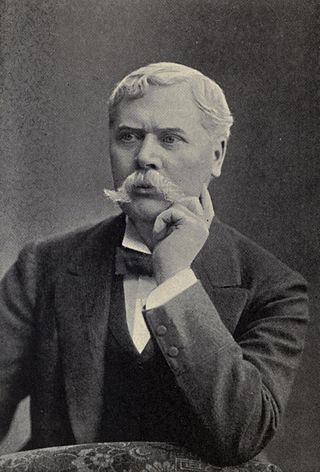
Marcus Stone was an English painter. Stone was born in London, and was educated at the Royal Academy.
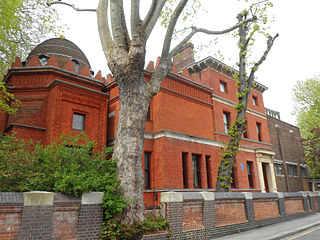
The Leighton House Museum is an art museum and historic house in the Holland Park area of the Royal Borough of Kensington and Chelsea in west London.
West Kensington, formerly North End, is an area in the ancient parish of Fulham, in the London Borough of Hammersmith and Fulham, England, 3.4 miles (5.5 km) west of Charing Cross. It covers most of the London postal area of W14, including the area around Barons Court tube station, and is defined as the area between Lillie Road and Hammersmith Road to the west, Fulham Palace Road to the south, Hammersmith to the north and West Brompton and Earl's Court to the east. The area is bisected by the major London artery the A4, locally known as the Talgarth Road. Its main local thoroughfare is the North End Road.
Fox Primary School is a primary school in London for children between the ages of 4 and 11, in the Royal Borough of Kensington and Chelsea. It is located on Kensington Place, between Kensington Church Street and Notting Hill Gate.

Little Holland House was the dower house of Holland House in the parish of Kensington, Middlesex, England. It was situated at the end of Nightingale Lane, now the back entrance to Holland Park and was demolished when Melbury Road was made. Number 14 Melbury Road marks its approximate location.
The Holland Park Circle was an informal group of 19th-century artists based in the Holland Park district of West London, England, especially in Melbury Road and Holland Park Road. George Frederick Watts, Frederic Leighton, Valentine Prinsep, Luke Fildes, Hamo Thornycroft and William Burges are considered key members of the group.
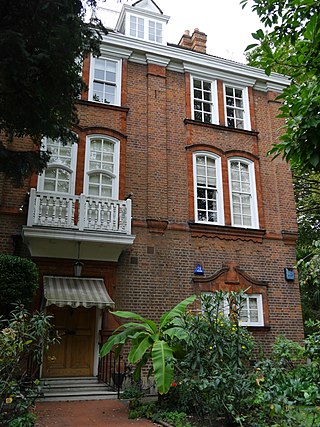
Woodland House is a large detached house at 31 Melbury Road in the Holland Park district of Kensington and Chelsea, West London, England. Built from 1875 to 1877 in the Queen Anne style by the architect Richard Norman Shaw, it is a Grade II* listed building. Commissioned by the painter Luke Fildes, Woodland House is next to William Burges's Grade I listed Tower House.

Debenham House at 8 Addison Road is a large detached house in the Holland Park district of Kensington and Chelsea, W14. Built in the Arts and Crafts style by the architect Halsey Ricardo, it is a Grade I listed building.

8 Melbury Road is a large detached house at the Holland Park district of Kensington and Chelsea, W14 in England. Built in the Queen Anne style by the architect Richard Norman Shaw, it is a Grade II* listed building.

Holland House, originally known as Cope Castle, was an early Jacobean country house in Kensington, London, situated in a country estate that is now Holland Park. It was built in 1605 by the diplomat Sir Walter Cope. The building later passed by marriage to Henry Rich, 1st Baron Kensington, 1st Earl of Holland, and by descent through the Rich family, then became the property of the Fox family, during which time it became a noted gathering-place for Whigs in the 19th century. The house was largely destroyed by German firebombing during the Blitz in 1940 and today only the east wing and some ruins of the ground floor and south facade remain, along with various outbuildings and formal gardens. In 1949 the ruin was designated a grade I listed building and it is now owned by the Royal Borough of Kensington and Chelsea.
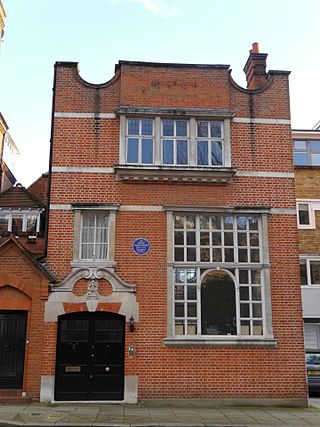
2b Melbury Road is a Grade II listed house in Melbury Road, Holland Park, London W14, built in 1877 by Sir John Belcher.

Colin Hunter was a Scottish artist of the Victorian era. Most of his works are seascapes.
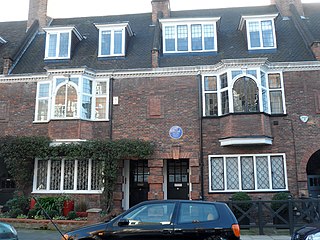
Mallord Street is a street in London, England in the Royal Borough of Kensington and Chelsea. It was named after Joseph Mallord William Turner who had lived in Chelsea. There are no other streets named Mallord Street in Great Britain.

Melbury Road is a residential road in the Holland Park area of the Royal Borough of Kensington and Chelsea, London, England. It is known for houses owned by the Victorian Holland Park Circle, an informal group of 19th-century artists, including William Burges, Luke Fildes, Frederic Leighton, Valentine Prinsep, Hamo Thornycroft, and George Frederick Watts.

18 Melbury Road is a large semi-detached house in the Holland Park district of Kensington and Chelsea, London W14, England, located just north of Kensington High Street. The house was built in Victorian times as a brick and stucco house with gas lighting by William Turner of Chelsea, London and originally sold on a 90-year lease.


















